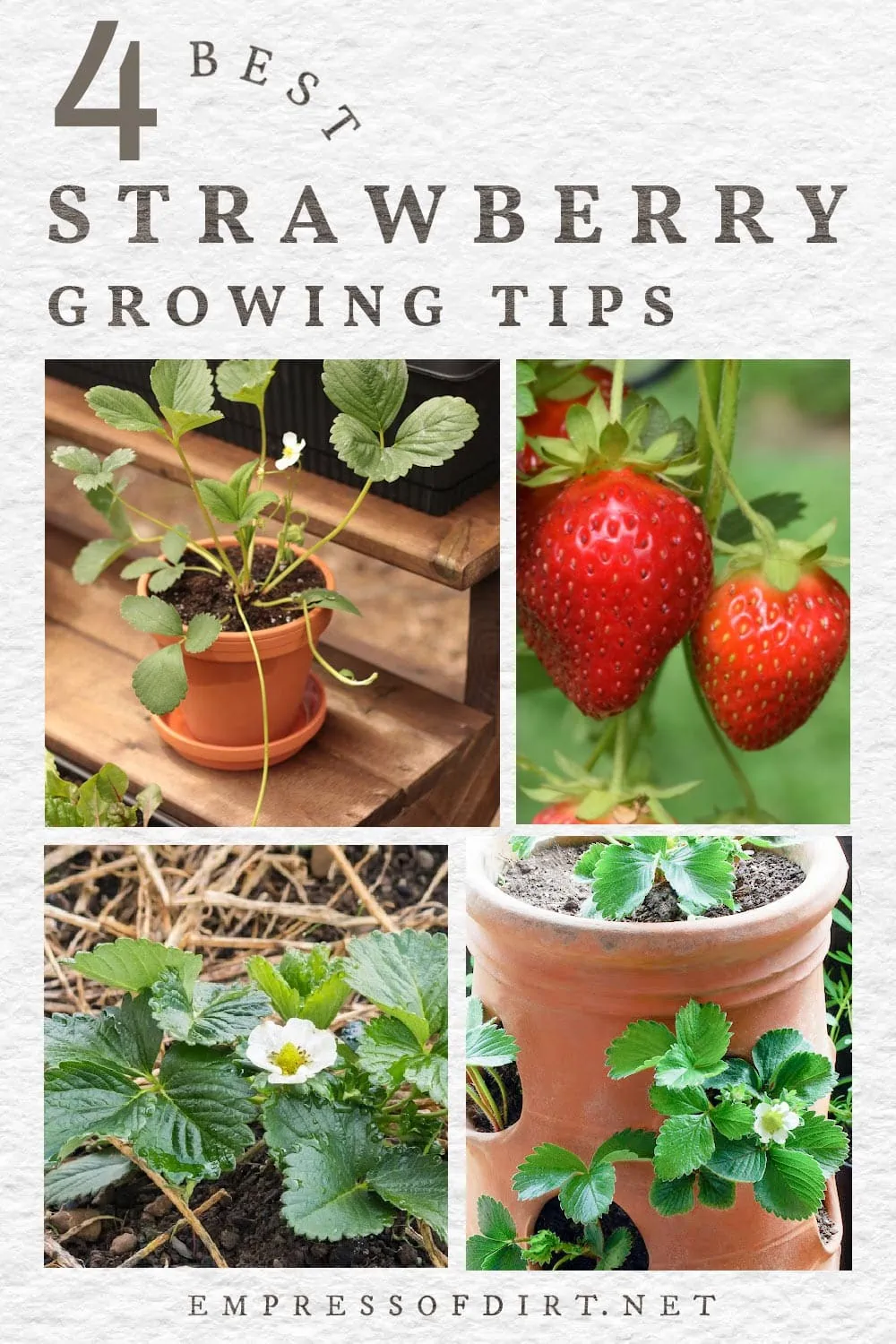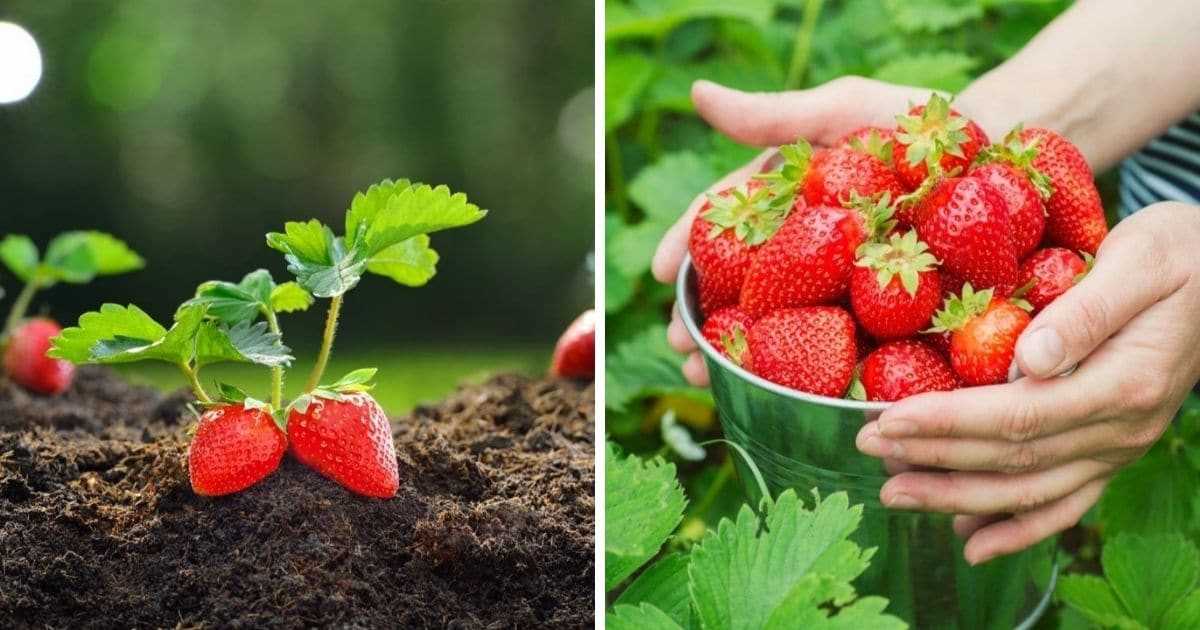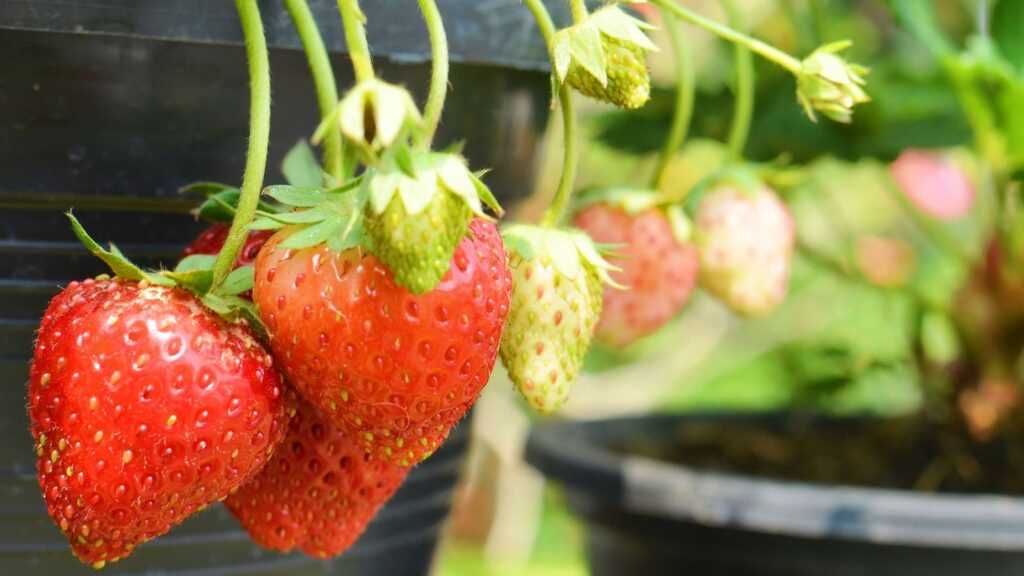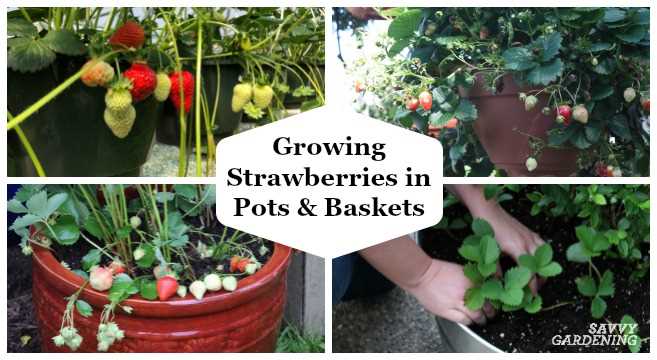- Preparing the Soil for Strawberry Seeds
- 1. Choose a Location
- 2. Clear the Area
- 3. Amend the Soil
- 4. Test the Soil
- 5. Create Raised Beds
- 6. Fertilize the Soil
- 7. Water the Soil
- 8. Mulch the Soil
- Selecting the Right Variety of Strawberry Seeds
- 1. Climate
- 2. Day Length
- 3. Disease Resistance
- 4. Taste and Texture
- 5. Harvest Time
- Germinating Strawberry Seeds
- Transplanting Strawberry Seedlings
- Steps for Transplanting Strawberry Seedlings
- Tips for Successful Transplanting
- Caring for Strawberry Plants
- 1. Provide Adequate Sunlight
- 2. Water Regularly
- 3. Mulch to Retain Moisture
- 4. Control Weeds
- 5. Feed Appropriately
- 6. Protect from Pests
- 7. Prune Runners
- 8. Monitor for Diseases
- Providing Adequate Watering for Strawberry Plants
- 1. Frequency
- 2. Deep Watering
- 3. Mulching
- 4. Watering in the Morning
- 5. Drip Irrigation
- 6. Monitor Soil Moisture
- Protecting Strawberry Plants from Pests and Diseases
- Pests
- Diseases
- Harvesting and Storing Strawberries
- 1. Choosing the right time to harvest:
- 2. Harvesting techniques:
- 3. Storing freshly harvested strawberries:
- 4. Freezing strawberries for long-term storage:
- Question-answer:
- Can I grow strawberries from seeds?
- What is the best time to start growing strawberry seeds?
- What is the ideal soil for growing strawberry seeds?
- How long does it take for strawberry seeds to germinate?
- Can I grow strawberries from seeds indoors?
- Video: How & When to Start Strawberry Seeds Indoors for Maximum Germination & First Year Berry Production
Growing strawberries from seeds can be a rewarding and cost-effective way to have an abundant supply of these delicious fruits in your garden. However, it can also be a bit challenging and requires a good understanding of the plant’s requirements. With the right knowledge and techniques, you can successfully grow strawberries from seeds and enjoy a bountiful harvest.
Choose the Right Seeds
When selecting strawberry seeds, it’s important to choose varieties that are suited to your climate and growing conditions. Different varieties have different requirements in terms of temperature, day length, and soil conditions. Research the various varieties available and choose ones that are known to perform well in your area. Look for seeds that are labeled as disease-resistant, as this can help ensure a healthier crop.
Provide Optimal Growing Conditions
Strawberries thrive in full sun, so choose a spot in your garden that receives at least 6-8 hours of direct sunlight each day. The soil should be well-draining and rich in organic matter. Before planting, amend the soil with compost or well-rotted manure to improve its fertility and drainage. It’s also important to ensure that the soil pH is within the optimal range of 5.5 to 6.5. Testing the soil and adjusting the pH if necessary can help promote healthy growth.
Sow and Care for the Seeds
When sowing strawberry seeds, it’s important to follow the instructions on the seed packet. Some varieties require a period of cold stratification to enhance germination, while others can be sown directly into the soil. Ensure that the seeds are evenly spaced and covered with a fine layer of soil. Water gently to keep the soil moist, but avoid overwatering, as this can lead to rotting. Once the seedlings emerge, thin them out to allow for proper airflow and prevent disease. Regularly water and fertilize the plants to ensure healthy growth.
“Growing strawberries from seeds may take a bit of time and effort, but the rewards are well worth it. With the right attention to detail and a little bit of patience, you can grow your own delicious strawberries and enjoy the satisfaction of knowing that you’ve nurtured them from seed to fruit.”
By following these expert tips, you can increase your chances of successfully growing strawberries from seeds. Remember to be patient and diligent in caring for your plants, and soon you’ll be enjoying the sweet taste of homegrown strawberries straight from your garden.
Preparing the Soil for Strawberry Seeds
Before planting strawberry seeds, it is important to prepare the soil to ensure that the seeds have the best possible chance of germinating and growing into healthy plants. Here are some expert tips for preparing the soil for strawberry seeds:
1. Choose a Location
Select a well-draining location for your strawberry seeds. Strawberries prefer soil that is rich in organic matter and has a pH level between 5.5 and 6.5. Avoid areas that are prone to waterlogging or have heavy clay soil.
2. Clear the Area
Remove any weeds, grass, or debris from the planting site. These can compete with the young strawberry plants for nutrients and moisture. Use a garden fork or rake to loosen the soil and remove any rocks or large clumps.
3. Amend the Soil
If the soil in your selected area is sandy or heavy clay, you may need to amend it to improve drainage and fertility. Incorporate organic matter such as compost, well-rotted manure, or peat moss into the soil. This will help improve soil structure and provide essential nutrients for the strawberry plants.
4. Test the Soil
If you are unsure about the pH level of your soil, consider testing it with a soil testing kit. Strawberry plants thrive in slightly acidic soil, so if the pH is too high, you may need to add sulfur or another acidifying agent to lower it.
5. Create Raised Beds
Consider creating raised beds for planting your strawberry seeds. Raised beds provide better drainage and can help warm the soil faster in the spring. They also make it easier to maintain the plants and harvest the strawberries.
6. Fertilize the Soil
Before planting your strawberry seeds, apply a balanced organic fertilizer to the soil according to the package instructions. This will provide nutrients for the young plants as they establish themselves.
7. Water the Soil
Before planting the strawberry seeds, water the soil thoroughly to ensure it is evenly moist. This will create a favorable environment for the seeds to germinate and for the roots to grow.
8. Mulch the Soil
After planting the strawberry seeds, apply a layer of mulch around the plants. Mulch helps retain moisture, suppresses weed growth, and regulates soil temperature. Use straw, wood chips, or another organic mulch material.
By following these soil preparation tips, you will increase the chances of successfully growing strawberries from seeds and enjoy a bountiful harvest of delicious berries.
Selecting the Right Variety of Strawberry Seeds
When it comes to growing strawberries from seeds, selecting the right variety is crucial to ensure a successful harvest. Here are some factors to consider when choosing strawberry seeds:
1. Climate
Different strawberry varieties thrive in different climates. Before selecting your seeds, it’s important to research the specific climate requirements of each variety and choose one that is well-suited to your region. This will increase the chances of your strawberries growing healthy and producing a bountiful harvest.
2. Day Length
Strawberry plants have different day length requirements for optimal growth and fruit production. Some varieties are better suited for longer daylight hours, while others can tolerate shorter days. Consider the average day length in your area and choose a variety that matches those conditions to ensure the best results.
3. Disease Resistance
Strawberry plants can be susceptible to various diseases, such as powdery mildew and gray mold. To minimize the risk of disease and ensure a healthy crop, look for strawberry varieties that are known for their disease resistance. These varieties are more likely to withstand common strawberry diseases and require less maintenance.
4. Taste and Texture
Every strawberry lover knows that taste and texture play a significant role in the enjoyment of these sweet fruits. Consider the flavor and texture profile of different strawberry varieties to find one that suits your personal preferences. Some varieties are known for their sweetness, while others have a more tart flavor. Similarly, some strawberries are juicier, while others have a firmer texture.
5. Harvest Time
If you have a specific time frame in mind for harvesting strawberries, it’s essential to choose a variety that aligns with your desired harvest period. Some varieties produce fruit earlier in the season, while others are late-bloomers. By selecting the right variety, you can ensure a plentiful harvest during your preferred time frame.
By considering these factors, you can select the right variety of strawberry seeds that will thrive in your specific growing conditions and provide you with delicious fruits to enjoy. Happy strawberry growing!
Germinating Strawberry Seeds
Germinating strawberry seeds is an essential step in successfully growing strawberries from seeds. Here are some expert tips to help you achieve successful germination:
- Choose high-quality seeds: Start with fresh, high-quality strawberry seeds for the best germination rates. Check for any expiration dates or indications of seed viability.
- Stratify the seeds: Many strawberry seeds require a period of cold stratification to break their dormancy and stimulate germination. This can be done by placing the seeds in a sealed plastic bag with a damp paper towel and refrigerating them for 4-6 weeks.
- Sterilize the planting medium: To prevent the growth of mold or fungi that can harm the germinating seeds, it is recommended to sterilize the planting medium. One method is to bake a mixture of equal parts peat moss, perlite, and vermiculite at 250°F (121°C) for 30 minutes.
- Moisten the planting medium: Before sowing the strawberry seeds, make sure to moisten the planting medium evenly. This will provide the necessary moisture for seed germination.
- Sow the seeds: Gently press the strawberry seeds into the moist soil, spacing them about 1 inch apart. Cover the seeds with a thin layer of the planting medium.
- Provide consistent moisture: Strawberry seeds require consistent moisture for successful germination. Mist the planting medium with water whenever it begins to dry out, but avoid overwatering, as this can lead to rot.
- Create a suitable environment: Place the containers in a warm location with indirect sunlight, such as a windowsill or a greenhouse, where the temperature stays between 65-75°F (18-24°C). Avoid placing the seeds in direct sunlight, as this can cause the soil to dry out too quickly.
- Be patient: Germination times can vary depending on the strawberry variety and environmental conditions. It is important to be patient and consistently monitor the moisture levels and temperature to ensure optimal conditions for germination.
By following these expert tips, you can increase your chances of successfully germinating strawberry seeds and starting your own strawberry plants from scratch. Good luck!
Transplanting Strawberry Seedlings
Once your strawberry seedlings have grown to a size where they have developed two to four true leaves, they are ready to be transplanted. Transplanting your seedlings properly is crucial for their successful growth and development.
Steps for Transplanting Strawberry Seedlings
- Choose the right time: It is best to transplant your strawberry seedlings on a cool, cloudy day or in the evening to reduce stress on the plants.
- Prepare the soil: Prior to transplanting, prepare the garden bed by removing any weeds and loosening the soil. Add compost or well-rotted manure to enrich the soil with nutrients.
- Water the seedlings: Before removing the seedlings from their container, water them thoroughly to ensure they are well-hydrated.
- Remove the seedlings: Gently remove the seedlings from their container, taking care not to damage the delicate roots. If the roots are tangled, gently separate them with your fingers.
- Plant the seedlings: Dig a hole in the prepared soil that is deep enough to accommodate the roots of the seedlings. Place the seedling in the hole, ensuring that the crown is level with the soil surface. Fill the hole with soil and gently firm it around the seedling.
- Water the transplanted seedlings: After planting, water the seedlings thoroughly to help them establish their roots in the new location.
- Provide ongoing care: Monitor the transplanted seedlings closely, making sure they receive adequate water and sunlight. Mulching around the seedlings can help conserve moisture and control weeds.
Tips for Successful Transplanting
- Handle the seedlings with care: Be gentle when removing the seedlings from their container and transferring them to the garden bed. Rough handling can damage the roots and hinder their growth.
- Plant at the correct depth: Make sure to plant the seedlings at the correct depth, with the crown level with the soil surface. Planting too deep or too shallow can affect their growth and survival.
- Water regularly: Keep the transplanted seedlings well-watered, especially during dry periods. Water deeply to encourage deep root growth.
- Protect against pests: Take measures to protect the seedlings from pests such as birds, slugs, and snails. Using netting or traps can help prevent damage to your plants.
- Monitor for signs of stress: Keep an eye out for any signs of stress, such as wilting or yellowing leaves. Address any issues promptly to ensure the health and vitality of your seedlings.
By following these steps and tips, you can successfully transplant your strawberry seedlings and set them up for healthy growth and a bountiful harvest. Happy gardening!
Caring for Strawberry Plants
Once you have successfully grown strawberry plants from seeds, it is important to properly care for them in order to ensure a bountiful harvest. Here are some essential tips for caring for your strawberry plants:
1. Provide Adequate Sunlight
Strawberry plants thrive in full sun, so make sure to plant them in a location where they will receive at least 6-8 hours of direct sunlight per day. This will help the plants grow healthy and produce plenty of sweet, juicy strawberries.
2. Water Regularly
Strawberry plants need regular watering, especially during the hot summer months. Keep the soil consistently moist, but not waterlogged. Water deeply to encourage the roots to grow deeper into the soil.
3. Mulch to Retain Moisture
Applying a layer of mulch around the strawberry plants can help retain moisture in the soil, prevent weed growth, and regulate soil temperature. Use straw, wood chips, or other organic mulch materials.
4. Control Weeds

Regularly remove weeds around the strawberry plants to prevent competition for nutrients and moisture. Be careful not to disturb the shallow strawberry roots while weeding.
5. Feed Appropriately

Strawberry plants benefit from regular feeding. Fertilize with a balanced, slow-release fertilizer according to the package instructions. Avoid using high-nitrogen fertilizers, as this can promote excessive foliage growth at the expense of fruit production.
6. Protect from Pests

Strawberry plants can be susceptible to pests such as slugs, snails, birds, and aphids. Protect your plants by using physical barriers, such as netting, and apply organic pest control methods if necessary.
7. Prune Runners
Strawberry plants produce “runners,” which are long stems that develop new baby plants. Prune these runners to prevent overcrowding and encourage the main plant to focus its energy on fruit production.
8. Monitor for Diseases
Keep an eye out for common strawberry plant diseases, such as powdery mildew or grey mold. If you notice any signs of disease, promptly remove and dispose of the affected plants to prevent the spread.
By following these care tips, you can ensure that your strawberry plants remain healthy and productive, giving you a delicious harvest of strawberries to enjoy.
Providing Adequate Watering for Strawberry Plants
Watering is one of the most crucial factors in growing healthy strawberry plants from seeds. Proper watering ensures that the plants receive enough moisture for growth and fruit production. Here are some expert tips to provide adequate watering for your strawberry plants:
1. Frequency
Strawberry plants need regular watering, especially during dry periods or when they are actively growing. Watering every 2-3 days is generally sufficient, but you may need to adjust the frequency based on weather conditions and the moisture levels of your soil. Avoid overwatering, as this can lead to root rot and other diseases.
2. Deep Watering
When watering your strawberry plants, make sure to provide deep irrigation. Shallow watering only wet the surface and does not reach the plant’s roots, which can lead to weak plants with shallow root systems. Deep watering helps the roots grow deeper into the soil, making the plants more resilient and better able to absorb nutrients.
3. Mulching
Mulching around your strawberry plants can help retain moisture in the soil and reduce the frequency of watering. Apply a layer of organic mulch, such as straw or wood chips, around the plants, leaving a gap around the stems to prevent rot. Mulch also helps control weeds and regulate soil temperature.
4. Watering in the Morning
It’s best to water your strawberry plants in the morning to allow the foliage to dry before evening. Wet foliage during the night can promote the growth of fungal diseases. Watering in the morning also ensures that the plants have enough moisture to withstand the heat of the day.
5. Drip Irrigation
Consider using drip irrigation for your strawberry plants, especially if you have a large planting area. Drip irrigation delivers water directly to the plant’s root zone, minimizing evaporation and water waste. It also helps keep the foliage dry, reducing the risk of diseases.
6. Monitor Soil Moisture
Regularly check the moisture levels of your soil to ensure that it is neither too wet nor too dry. Stick your finger into the soil up to the first knuckle – if it feels moist, you can hold off on watering for a bit. If the soil feels dry, it’s time to water your strawberry plants.
By following these tips and providing adequate watering for your strawberry plants, you can ensure their health and productivity, resulting in bountiful harvests of delicious strawberries.
Protecting Strawberry Plants from Pests and Diseases
Pests

Aphids: These small insects can cause significant damage to strawberry plants by sucking sap from the leaves and stems. To control aphids, introduce natural predators such as ladybugs or use insecticidal soap.
Slugs and snails: These pests are a common problem in strawberry gardens. To deter them, remove any debris or hiding spots near the plants, and consider using copper tape or diatomaceous earth around the base of the plants. You can also handpick slugs and snails in the early morning or evening when they are most active.
Strawberry Bud Weevils: These weevils can cause significant damage by feeding on flower buds, resulting in reduced fruit production. To control them, spray affected plants with neem oil or use insecticidal products specifically designed for weevil control.
Diseases
Gray mold (Botrytis cinerea): Gray mold can cause significant damage to strawberry fruits and plants. To prevent it, provide good air circulation around the plants by spacing them properly and removing any dead or decaying plant matter. Fungicides may also be necessary in severe cases.
Powdery mildew: Powdery mildew is a fungal disease that can affect both strawberry leaves and fruits. To prevent it, avoid overhead watering and ensure proper spacing between plants. Fungicides can also be used to control the disease if necessary.
Verticillium wilt: This soilborne fungus can cause wilting, stunted growth, and eventually death of strawberry plants. To prevent it, plant disease-resistant varieties and avoid planting strawberries in the same location year after year. Proper sanitation and crop rotation are also important in reducing the risk of infection.
The key to successfully protecting strawberry plants from pests and diseases is to regularly monitor your plants for any signs of damage or infestation. Taking proactive measures and treating any issues early on will help ensure a bountiful harvest of healthy strawberries.
Harvesting and Storing Strawberries
Harvesting strawberries is an exciting part of growing your own fruit. It’s important to pick strawberries at the right time to ensure they are ripe and delicious. Here are some tips for harvesting and storing strawberries:
1. Choosing the right time to harvest:
Strawberries should be harvested when they are fully red and have a glossy appearance. Ripe strawberries are also fragrant and have a sweet smell. Avoid picking strawberries that are still green or white as they will not have reached their full flavor potential.
2. Harvesting techniques:
Gently twist or snap the stem of the strawberry to detach it from the plant. It’s recommended to wear gloves while picking strawberries to protect your hands from scratches and stains. Be careful not to bruise or squish the strawberries while harvesting as this can lead to spoilage.
3. Storing freshly harvested strawberries:
- Do not wash the strawberries before storing them, as moisture can promote mold growth.
- Remove any damaged or spoiled strawberries from the batch to prevent them from spoiling the others.
- Place the strawberries in a single layer in a shallow container or on a paper towel.
- Store the container in the refrigerator to keep the strawberries fresh. They can be stored for up to a week.
4. Freezing strawberries for long-term storage:
- Wash the strawberries gently and remove the stems.
- Spread the strawberries on a baking sheet lined with parchment paper in a single layer.
- Place the baking sheet in the freezer until the strawberries are completely frozen.
- Transfer the frozen strawberries to a freezer-safe bag or container and label them with the date.
- Stored this way, strawberries can last in the freezer for up to 6 months.
Remember that strawberries are best enjoyed fresh, so try to consume them as soon as possible after harvesting. Whether you eat them right away or store them, homegrown strawberries are a delicious treat!
Question-answer:
Can I grow strawberries from seeds?
Yes, you can grow strawberries from seeds. It requires more patience and care compared to growing them from established plants, but it can be a rewarding and cost-effective way to start your own strawberry patch.
What is the best time to start growing strawberry seeds?
The best time to start growing strawberry seeds is in the late winter or early spring, when the soil temperature is still cool. This will allow the seeds to germinate properly and develop into strong seedlings.
What is the ideal soil for growing strawberry seeds?
The ideal soil for growing strawberry seeds is well-drained and slightly acidic, with a pH level around 5.5 to 6.5. You can improve the soil by adding organic matter, such as compost or well-rotted manure, to provide the nutrients necessary for healthy plant growth.
How long does it take for strawberry seeds to germinate?
Strawberry seeds can take anywhere from 2 to 4 weeks to germinate, depending on the temperature and conditions. It’s important to keep the soil consistently moist but not saturated during this time to promote germination.
Can I grow strawberries from seeds indoors?
Yes, you can grow strawberries from seeds indoors. Using seed trays or pots filled with seed-starting mix, sow the seeds and keep them in a warm and well-lit area. Once the seedlings have developed a few sets of true leaves, they can be transplanted outdoors in the garden.







